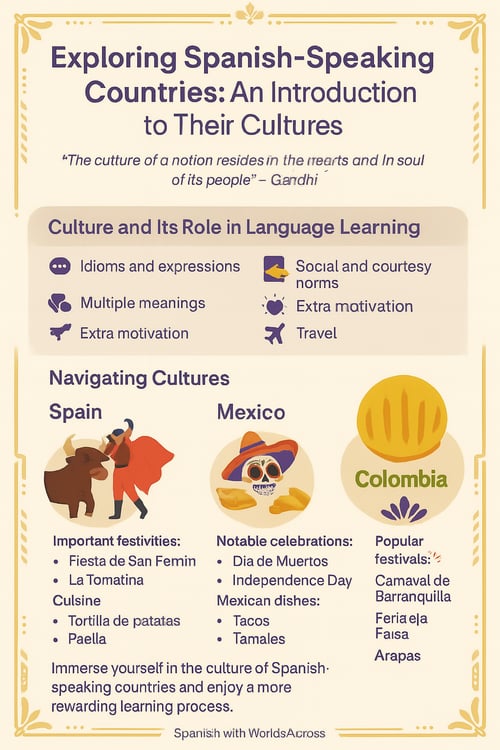Exploring Spanish-Speaking Countries: Introduction to Their Cultures

"The culture of a nation resides in the hearts and in the soul of its people." — Mahatma Gandhi
Learning Spanish as a second language isn’t just about memorizing words and grammar rules; it involves exploring the cultural roots of Spanish-speaking countries. In fact, one could argue that it's almost impossible to learn Spanish without immersing yourself in Hispanic culture.
For learners, diving into the culture of Spanish-speaking lands, rich in history, traditions, and festivals, provides crucial context for understanding the language. It also makes the learning process more enjoyable and rewarding.
Join us and discover how embracing the culture of Spanish-speaking countries can boost your learning journey!
Culture and Its Role in Language Learning
- Idioms and Expressions: Using idiomatic expressions reflects a high level of language mastery, but these expressions also carry significant cultural connotations. Immersing yourself in the culture will help you understand and use them more effectively.
- Multiple Meanings: Many words in Spanish have regional variations. For instance, the word "cacho" can mean infidelity in some countries, while in others it simply means a piece of something.
- Social and Courtesy Norms: Courtesies can vary significantly among Spanish-speaking countries. Cultural immersion helps you understand these differences and use them to communicate effectively.
- Extra Motivation: Discovering customs, gastronomy, and traditions makes the learning process more interesting and exciting, which in turn increases motivation.
- Travel: Traveling and experiencing the culture of Spanish-speaking countries firsthand provides a complementary context that greatly enhances Spanish language learning.
Navigating Cultures
Now that you understand the importance of Hispanic culture for Spanish learners, get ready! We’ll explore three Spanish-speaking countries full of identity and cultural richness. Let’s go!
Spain
First on the list is Spain. This beautiful country in southwestern Europe is a global symbol of culture. ¡Olé!
- Important Festivities:
- Fiesta de San Fermín: One of the world’s biggest festivals, the Fiesta de San Fermín draws thousands of people each year, who, driven by a festive spirit, participate in a running with six released bulls. What a motivation!
- La Tomatina: Have you ever heard the saying "don't play with food"? In Spain, this rule is followed until the last Wednesday in August in Buñol, when locals throw tomatoes at each other, turning this event into the world’s largest tomato fight.
- Cuisine:
- Tortilla de Patatas: A dish made from fried potatoes and beaten eggs.
- Paella: A mix of rice with meat or seafood.
Mexico
We couldn't discuss Hispanic culture without mentioning vibrant Mexico. With its colorful Día de los Muertos and extravagant cuisine, Mexico is synonymous with cultural wealth. ¡Qué chido!
- Notable Celebrations:
- Día de Muertos: Celebrated in early November, this event represents the temporary return of deceased relatives and honors their memory with colors, dances, and songs. Extravagant altars are decorated with candles, marigold flowers, photos, food, and favorite items of the deceased.
- Independence Day: Every September 15th at night, Mexicans reenact the Grito de Dolores, a call for independence made by Miguel Hidalgo in 1810. This celebration is filled with music, traditional folk dances, food, and fireworks, creating an atmosphere of excitement and celebration.
- Mexican Dishes:
- Tacos: Corn tortillas rolled with various ingredients like meat, sausages, salsas, and vegetables.
- Tamales: Corn dough filled with ingredients like meats, vegetables, and chiles, wrapped in corn husks or banana leaves.
Colombia
Next, we arrive in Colombia! Located in the northwestern region of South America, this beautiful land is famous for vallenato music and coffee production, showcasing vast cultural richness. ¡Qué bacanería, ome!
- Popular Festivals:
- Carnaval de Barranquilla: One of Latin America’s most important carnivals fills the streets with music, dance, and parades of traditional costumes. "La Batalla de las Flores," a parade of colorful flower-adorned floats that tell specific stories, stands out. Of course, cumbia, vallenato, dance groups, and costumes are essential elements.
- Feria de las Flores: Medellín comes alive in August with the Feria de las Flores, which includes concerts and art exhibitions. Flower growers compete with beautiful "silletas," floral structures, to win the title of best silleta in the parade.
- Colombian Cuisine:
- Bandeja Paisa: A varied dish that includes rice, meat, beans, ripe plantain, fried egg, pork rind, avocado, arepa, and sausage.
- Arepas: Thick corn flour tortillas filled with cheese, egg, beans, meat, chicken, etc.

Exploring the culture of Spanish-speaking countries is vital for all learners, regardless of their level. In fact, avoiding the connection between culture and language is nearly impossible, as we mentioned earlier.
Familiarizing yourself with the festivals, art, and gastronomy of Latin America provides essential context that brings the language to life and makes it more exciting for beginners. As a result, your vocabulary improves, and learning becomes more engaging and rewarding.
Don’t underestimate the positive influence of Hispanic culture for Spanish beginners. Immerse yourself in the culture of Spanish-speaking countries and enjoy a more enjoyable and enriched learning process.
Good luck!



